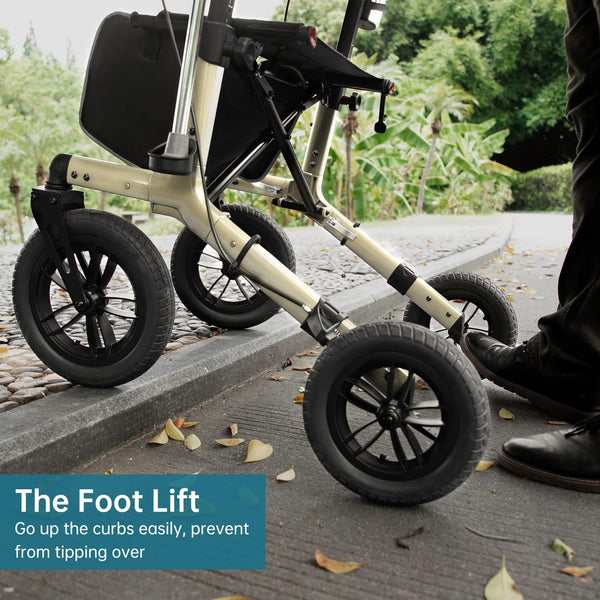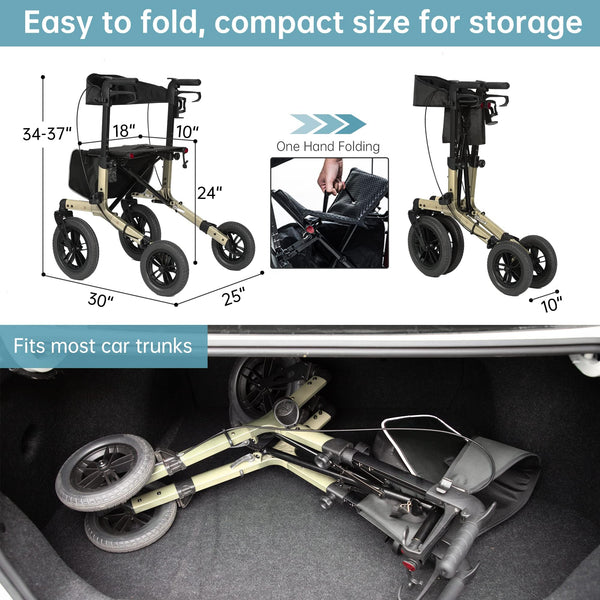Are Rollator Walkers with Seats Safe on Stairs?
May 26, 2025
Today we are going to talk about using a rollator walker with seat on stairs. If you or someone you know uses one of these handy walking aids, you’ve probably wondered: “Can I just take it up or down the stairs?” The short answer? Nope. And here’s why that’s a pretty big deal.
What’s the Deal with Rollators and Stairs?
First off, rollator walkers—especially the kind with a seat—are designed for smooth, flat surfaces. Think hallways, sidewalks, grocery store aisles. They’re not built for navigating stairs, even short ones.
Stairs require balance, strength, and careful footwork. Add a wheeled walker into the mix, and you’ve got a recipe for a serious fall. Even the most lightweight rollator walker can be awkward to handle when you’re dealing with steps. And if you’re using a rolling walker because of balance or mobility issues, stairs just make things that much riskier.

Elenker KLD-9212 ELENKER All-Terrain Rollator Walker with 12" Wheel for curbs instead of stairs
Why It’s Risky
1. Wheels Don’t Lock Perfectly
Even if your rollator has wheel locks, they’re designed to keep it steady on flat ground—not to stop it from rolling off a stair. The brakes can slip, especially if the angle of the stairs is steep or if the surface is uneven. One tiny slip, and boom—you’re in trouble.
2. Balance Is Already Tricky
Using a walker usually means you’re trying to improve stability. But when you try to lift or maneuver a rollator with a seat up a set of stairs, your center of gravity shifts, and your balance goes out the window. You could tip forward, backward, or sideways—none of which ends well.
3. They’re Awkward to Carry
Even a folding rollator walker is kind of bulky. Some weigh over 15 pounds, and when you throw in the seat, storage bag, and accessories, it’s not exactly easy to carry. Trying to lug it up stairs while also keeping yourself upright is no small feat.

Elenker KLD-9212 ELENKER All-Terrain Rollator Walker fits most car trucks.
4. You Could Damage the Walker
Dragging your rollator up and down stairs can mess with the frame, wheels, or brakes over time. And if something breaks while you're using it later? That’s a whole new danger zone.
Don’t Use Your Rollator on Stairs
We’re not saying this to be dramatic—it’s genuinely not safe. Most manufacturers clearly state in their manuals not to use the walker on stairs. It’s just not what they’re made for.
Even if it’s a short flight—like three steps at your front porch—it’s better to avoid taking the walker with you. The risk just isn’t worth it.
So What Are Your Options?
Okay, so if using your rolling walker on stairs is off the table, what can you do instead? Here are a few safer alternatives:
1. Use a Handrail
If you’re strong and steady enough to go up and down stairs on your own, use the handrail and leave the walker at the top or bottom. Just be careful and take your time.
2. Keep a Second Walker
Some folks find it helpful to keep one lightweight rollator walker upstairs and another one downstairs. That way, you don’t have to carry anything. You just walk up or down carefully and have a walker waiting for you.
3. Ask for Help
If you need your walker on both floors but can’t carry it yourself, ask a family member or caregiver to help you move it. Don’t be shy—better to ask than risk a fall.
4. Install a Ramp or Lift
If stairs are part of your everyday routine and you’re struggling, it might be time to look into more permanent solutions. Ramps, stairlifts, or even converting a small set of stairs into a gradual slope could make a big difference.
Folding Rollators Don’t Make It Safer
Some people think a folding rollator walker is safe to carry on stairs because you can collapse it and hold it by the frame. But that still doesn’t make it a good idea.
Sure, it might be a little easier to carry, but it’s still bulky, and if you lose your grip or stumble, you could drop it—or worse, fall yourself. The folding feature is great for tossing it in the car or stashing it in a closet, but it doesn’t make it stair-friendly.
Watch Out for Curbs and Steps, Too
It’s not just full staircases that are dangerous. Even curbs, porch steps, or a couple of stairs into a store can cause problems. Always be cautious and don’t assume it’s safe just because it’s “only one step.” Accidents happen fast.
If you have to step up or down, stop, park your walker, and go slowly. If the rollator feels unstable, leave it behind and ask for help or look for a ramp.
What If You Live in a Two-Story House?
This is a common situation, and it can be tricky. A few tips that might help:
Keep essential items on each floor so you don’t have to go up and down too often.
Use a different mobility aid for stairs, like a cane or just the handrail, and leave the rollator on the landing.
Talk to a physical therapist about your specific needs. They can suggest safer techniques and maybe even a stair training session.
To sum it all up: using a rollator walker with seat on stairs just isn’t safe. Doesn’t matter if it’s a lightweight rollator walker, a rolling walker, or a fancy folding rollator walker—stairs and wheels don’t mix.
There are safer ways to get around, whether that means keeping a second walker on a different floor, using the handrail, or asking for help. Mobility is super important, but safety always comes first.
So next time you’re tempted to lift that rollator onto a step or wheel it down the porch - just don’t. Your future self will thank you.











